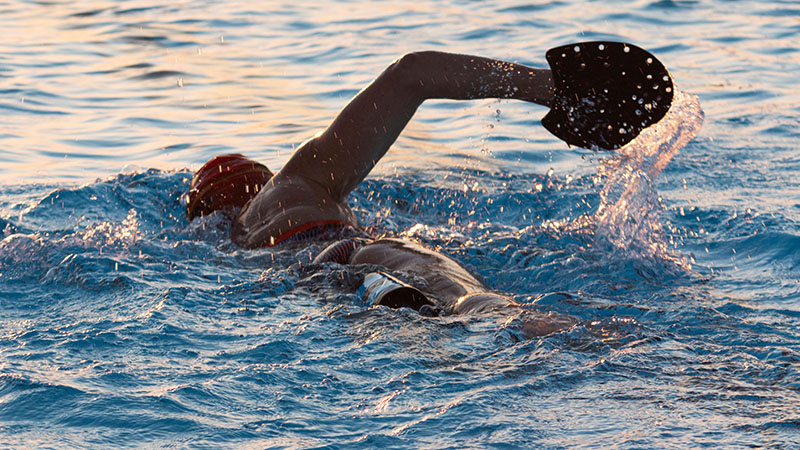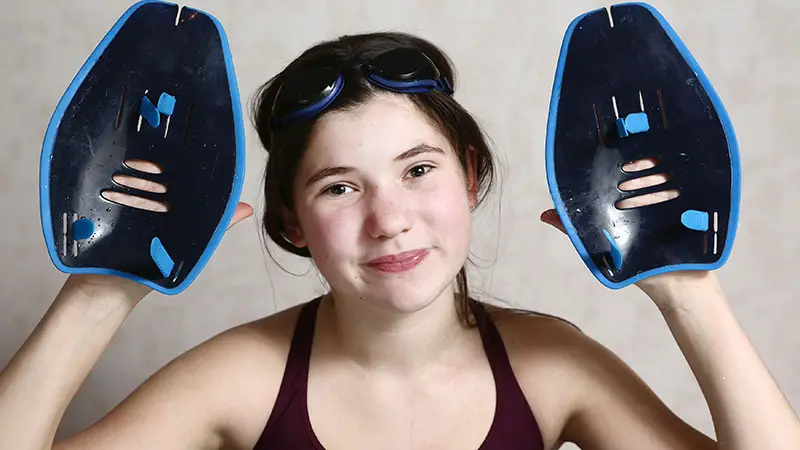Contents
If you’re new to swimming as a workout or you’re looking to change up your swimming routine, there are all kinds of different training aids to spice things up and target different areas. From fins to kickboards, these tools have different practical purposes in improving your form, speed, and strength in the pool. The same goes for swimming with paddles.
Knowing how to swim with paddles properly can definitely step up your swimming game, whether you’re training for a triathlon, preparing for a swim meet, or simply target new areas while swimming. Let’s explore what, exactly, paddles are, determine whether they are necessary for your future swimming regime, and how to swim with them.
What are Swim Paddles?

When I think about paddles, I immediately picture the paddles that people use when kayaking. These types of paddles are completely different! Essentially, swimming paddles are these apparatuses that connect to each of your hands while you are swimming. They remind me a little of those old school velcro paddles you would attach to your hand and play catch with a velcro ball. You know the ones? Well, imaging that, but with better materials, more comfortable, and swimmer friendly! Or that’s how I think of it, at least!
There are several reasons swimmers would use paddles during their training, and we’ll address those in the benefits below! But, before we go there, let’s talk about how to swim properly with them.
How to Swim with Paddles
It’s important that you have a solid understanding of proper swimming form before jumping into the water with paddles. If you have a good swimming form and feel confident using paddles for some added benefits, here’s how you use them…
First, make sure that you secure the paddles on your hands. For more experienced swimmers, they may not need as many of the provided straps because they can keep them secured with technique.
If you’re using the paddles with a freestyle stroke, swim as you typically would, just make sure that your paddles are facing down against the water to create tension and prevent the paddle from slipping off. Once you get the hang of keeping the tension with your paddles, you can simply enjoy your swim as you typically would with the added benefits listed below.
Benefits of Swim Paddles

There are a great number of benefits for incorporating paddles into your typical swimming routine! While I couldn’t name them all, here are some of the most important ones I could find…
Strengthens Upper Body
One of the most important and commonly known benefits of swimming with paddles is its effect on the upper body. When used and sized correctly, paddles require your upper body, such as your forearms and your shoulders, to overcompensate and work harder. Thus, this harder work can often translate to stronger muscles in your upper body.
Increase Speed
Similar to using fins and its effects on your lower body and speed, paddles have the same effect on your upper body. The added tension allows you to propel your body at a faster rate than usual when you don’t have the paddle to assist you!
Trains Your Technique
A lot of swimmers enjoy using paddles in their swimming regimen because the way you have to do them in order to keep the tension allows you to learn how to pull strongly through the water and work on the follow through and finish of your freestyle stroke. Essentially, you’ll have a better “catch” because of knowing how to swim with paddles properly.
Change Up
With fitness, it’s always good to change things up! If you have been in a swimming routine for some time now, and you haven’t been using any swimming aids, you should definitely consider paddles. As with any tool that you use to improve your fitness, using them intermittently allows you to shake up your routine, shock your muscles, and bring even better results.
Drawbacks of Swim Paddles
As with everything, there are both positives and potential negatives. Just as there are many benefits to using paddles with swimming, there are also some potential drawbacks that you’ll definitely need to consider and be aware of.
Added Strain
The first drawback is definitely something to consider if you have a history of upper body joint pain, specifically in your shoulders and wrists. Because fins work your upper body more and build strength in that area, this means that you are also using these muscle groups and joints more intensely than with a typical swim workout. This increase in intensity can definitely add extra strain to this area. So, if you are using paddles and have a history of upper body injuries, make sure you are using properly fitted paddles, correct form, and that you’ve cleared this with your physician.
Overreliance
Because you can swim faster with paddles, some may develop an overreliance for their paddles. It can be challenging going from swimming your fastest every time to putting the paddles away and your workout taking longer. But if you enjoy using paddles, then you need to make sure that you do not rely on them too heavily and keep mixing things up in the pool.
Hand Formation
Swimming with paddles can also affect your hand formation when swimming without them. With the way paddles are shaped, you are often spreading your fingers wide when swimming. While this isn’t necessarily a bad thing, it can turn into a definite drawback if you transfer it over into your typical swimming.
Tips for Using Swim Paddles

Even though we’ve discussed how to swim with paddles, there are some tips you might find helpful before diving into the pool. Here are the top three tips for successfully using swim paddles in your swimming workouts.
Fitting
There is a lot of discussion about proper fitting for paddles. If your paddle is too big, it can really strain your shoulders and potentially cause an injury. If your paddle it too small, it can be uncomfortable and ineffective. Ideally, you want a paddle that is a little bigger than the size of your hand unless you are a professional or highly competitive swimmer.
Be Mindful of Straps
The consensus of strapping your hands into paddles is that the fewer straps you use, the better. Ideally, you want to use the paddles in a way that is as close to swimming without them as possible to heed the most results. Using the straps to the fullest in order to get the hang of it is completely acceptable and encouraged, however, as you get more confident try using less so that your hands and form don’t grow too accustomed to paddles that it transforms to your normal swimming techniques.
Avoid Certain Strokes
Learning how to swim with paddles for the freestyle is perfect, but other strokes like the breaststroke and the butterfly that are much more complicated and involved may not be as beneficial with paddles. Most suggest leaving paddles with those strokes to the professionals and Olympic swimmers, so just take that into consideration!
